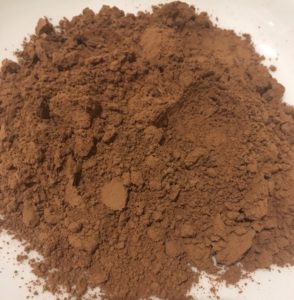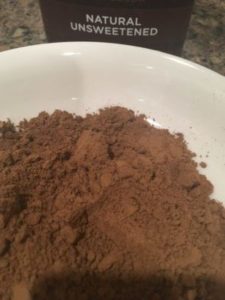Difference Between Natural And Dutch Processed Cocoa Powder... What? Are they different?
The moment we think of chocolate flavour...Cocoa powder pops up in our mind.
Cocoa Powder... the most important ingredient for making chocolate cake or chocolate sauce or choco shakes or chocolate ice cream or Brownies or chocolate frosting or anything else that is chocolatey.
But do you know there are 2 types of cocoa powder? Frankly speaking, I didn't. For me, cocoa powder meant just cocoa powder. Lately, though I have been seeing the labels as 'natural or 'Dutch processed" but never paid any attention to it. Never tried to understand the meaning of these terms. Thought that maybe these are just associated with the brands only.
Though I tried to overlook this but every time I used cocoa powder in any of my recipes the doubt came to my mind as to whether I am using the natural cocoa powder or Dutch processed. And finally, I decided to clear this doubt and started reading about these two terms. After thorough study things became quite clear and now I know which cocoa powder I am using. Also, I understood that the cocoa powder, I have been using since ages is natural cocoa powder only.
First, let us see what is cocoa powder. Cocoa powder is made from cocoa beans. The beans are fermented, dried, roasted and cracked into nibs. But as these beans contain a lot of butter. So, using a hydraulic press about 60% to 90% of the cocoa butter is removed from the cocoa nibs. Thereafter the remaining paste is dried, powdered and sieved to produce cocoa powder.
Both Dutch-process and natural cocoa are made from cocoa beans. Then what is the difference between Natural and Dutch-processed Cocoa powder? If I have to answer this in one word then the answer is acidity. The natural cocoa powder is acidic whereas Dutched cocoa powder is neutral.
Is Cocoa powder acidic? Surprised? But true. Now you understand when in my article of the difference between baking powder and baking soda, it is said, ''when baking soda is mixed with either of the acids like curd or vinegar or cocoa powder then a chemical reaction takes place."
Let us see this in detail.
But before that... just a minute...even if you understand chemistry only at the basic level, like me, then you must be knowing about pH. pH meaning potential of Hydrogen pH is a scale of acidity from 0 to 14. pH of 7 means neutral solution. Water and blood are neutral having a pH value of 7. Anything less than 7 is acidic whereas more than 7 indicates that it is Alkaline. Like lemon juice and vinegar has a pH of 2.4 and 3 respectively. Similarly, seawater and baking soda have pH of 8 and 9.5 respectively. To know more about pH read here.
Another important thing in this context is the knowledge about baking soda and baking powder. To find out how they are different from each other, read here.
Other articles which may be of interest to you are:
Difference Between Baking Powder and Baking Soda;
Difference Between Brownie and Cake; 16 Tips For Baking Good Cake ;
Why sift flour; Why Preheat Oven; Olive Oil in Kitchen; AllAbout Yeast ;
Tips for Perfect Whipped Cream
After knowing about pH and baking soda and baking powder, it is easier to understand the difference between Natural cocoa and Dutch Cocoa.
Natural Cocoa Powder
Natural Cocoa Powder is obtained from roasted cocoa beans. It is very light brown in colour, strong and has concentrated chocolate flavour. It is acidic and bitter with ph value ranging from 5.3 to 5.8. It is not easily soluble in water or milk.
Being acidic in nature, natural cocoa powder requires a BASE like baking soda to neutralise its bitter taste. When ACID in Natural Cocoa Powder reacts with the BASE Baking Soda, then bitterness goes away and in addition, they both allow your baked goods to rise. And if this natural cocoa powder does not get baking soda to react with then its bitterness stays and is transferred to the baked goods.
It is more popular in America.
Some of the common brands of natural cocoa powder are Cadbury's, Hershey's, Ghirardelli, and Scharffen Berger.
Dutch Cocoa Powder
Dutch-processed or Dutch Cocoa Powder was created in the 19th century by a Dutchman named Coenraad J. van Houten. As the Natural cocoa powder is bitter in taste and can not be easily dissolved in liquids so he thought of creating a cocoa powder which can be easily added to water or milk to make a delicious chocolate drink. And he did this by reducing the acidity of cocoa beans by soaking them in potassium carbonate.
Dutch-process or alkalized cocoa is obtained from cocoa beans that have been soaked in an alkaline solution of potassium carbonate. It is chemically processed to reduce/neutralize the acidity and harshness of natural cocoa which in turn reduces the bitterness and also improves its solubility.
It has a pH value ranging between 6.8 to 8.1 depending on the duration of the soak.
It is darker in colour, anywhere from brownish red to almost black and has a smooth flavour.
Because of this, Dutch-process cocoa is often preferred when "dusting" or garnishing a finished cake or desserts.
Being neutral, Dutch processed cocoa powder reacts well with baking powder.
It is more popular in Europe.
Difference Between Natural And Dutch Processed Cocoa Powder |
||
|
Properties |
Natural |
Dutch Processed |
|
Nature |
Acidic |
Neutral/Alkaline |
|
pH |
5.3-5.8 |
6.8 - 8.1 |
|
Colour |
Light Brown |
Dark Brown |
|
Reacts with |
Baking Soda |
Baking Powder |
| Taste | Bitter & Harsh |
Milder & more |
|
Solubility in Water/Milk |
Difficult to dissolve |
Easily Soluble |
How to identify Natural orDutch Cocoa Powder ?
Though most of the Cocoa powders specify whether the cocoa powder is natural or dutch processed. But in case it does not specify then don't be alarmed. Look at the ingredients.
If the ingredients list 'cocoa' or '100% cocoa' or 'unsweetened cocoa powder' then it means it is natural cocoa powder.
Similarly, if the ingredients say 'cocoa processed with alkali' or 'alkalised' or 'potassium Carbonate' or 'acidity regulator' then it means it is dutch processed.
If labelled then, of course, they are identified. But if not labelled then?
The first test is colour only. Light colour meaning natural and dark colour meaning Dutch. But colours can be deceiving and one cannot be sure.
Secondly, taste it. If too bitter then Natural otherwise Dutched.
Thirdly, vague reason but true. Dutch cocoa powder is much more expensive than Natural cocoa powder.
But again if you don't have anything to compare with then how to determine which is more bitter than the other.
So, we can perform a simple experiment. Since natural is acidic and reacts with baking soda so to check, add little baking soda in your cocoa powder. Now add some water. If bubbles appear it means it is natural. If no reaction then it is Dutched.
Use Natural or Dutch Cocoa?
In a recipe, if the leavening agents, baking soda and baking powder are not used then you can use either of the two. Like for making the chocolate sauce or pudding or shakes or ice cream or chocolate frosting.
Also, if a recipe uses both baking powder and baking soda then you can use any cocoa powder, it doesn't make any difference (unless specified otherwise)
But if a recipe uses only baking powder then use only Dutch-processed cocoa powder and
If a recipe uses only baking soda then use only natural cocoa powder.
Confused? Okay, follow this rule of thumb:
Use "Natural Cocoa Powder" only unless mentioned "Dutch processed Cocoa Powder" in the recipe.
Normally, when a recipe mentions 'çocoa powder' then it means natural cocoa powder only. If a recipe requires dutch cocoa powder then it mentions it clearly.
SUBSTITUTION
As far as replacing one for the other, it is better to use as per the recipe.
However, the famous and iconic 'King Arthur Flour' sells five different types of cocoa powder and according to The King Arthur Flour Baker’s Companion:
If a recipe calls for natural cocoa and baking soda, and you want to use Dutch-process cocoa, substitute an equal amount of Dutch process cocoa but replace the soda with twice the amount of baking powder, leaving the remaining ingredients the same.
If a recipe calls for Dutch-process cocoa and baking powder, and you want to use natural cocoa, substitute an equal amount of natural cocoa but replace the baking powder with half the amount of baking soda, leaving the remaining ingredients the same.
If this creates a lot of confusion then the best is, as I said earlier, follow the recipe.
Hope you enjoyed reading this article. Your comments as well suggestions, like always, are welcome.
My heartfelt thanks to the following links as the above article is compiled based on the information provided therein.
- www.wikipedia.org
- www.sallysbakingaddiction.com
- www.whatsarahbakes.com
- www.kingarthurflour.com
- www.chowhound.com
If you have liked this post or any of my earlier posts then do leave a comment. Your feedback fuels my enthusiasm to post more good content. You can join me on my FB page for more tips and tricks. Also, you can pin this post for future reference.
Happy Baking
Samira



